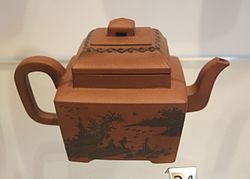Stoneware

Stoneware is a broad term for pottery or other ceramics fired at a relatively high temperature.[2][3] It may or may not be glazed.[4] It was developed after earthenware and before porcelain. Stoneware can be made from a much wider range of clays than porcelain.
Historically, reaching high temperatures was a big challenge. Lower temperatures were used for a long time. Earthenware can be fired as low as 600°C. This was done in primitive pit firing, but 800 °C (1,470 °F) to 1,100 °C (2,010 °F) was more typical.[5]
As a rough guide, modern earthenwares are normally fired in a kiln at temperatures in the range of about 1,000°C (1,830 °F) to 1,200 °C (2,190 °F); stonewares at between about 1,100 °C (2,010 °F) to 1,300 °C (2,370 °F); and porcelains at between about 1,200 °C (2,190 °F) to 1,400 °C (2,550 °F).
Stoneware Media
American stoneware jug with Albany slip glaze on the top, c. 1900, Red Wing, Minnesota
A Staffordshire pottery stoneware plate from the 1850s with white glaze and transfer printed design. Visually this hardly differs from earthenware or porcelain equivalents.
Chinese Yixing teapot, Qing dynasty, c. 1765–1835, with painted slip.
Wedgwood jasperware salt cellar with The Dancing Hours, 1780–1785
Salt glazed jug by Doulton, England, 1875
Coade stone lion at Twickenham Stadium
References
- ↑ "Tea Bowl with "Hare's-Fur" Glaze". Metropolitan Museum of Art. 2012-11-30. Retrieved 2013-02-19.
- ↑ Clay vitrifying temperatures
- ↑ Arthur Dodd & David Murfin. Dictionary of Ceramics; 3rd edition. The Institute of Minerals, 1994.
- ↑ Encyclopædia Britannica Jasperware is unglazed stoneware
- ↑ Medley, Margaret 1989. The Chinese potter: a practical history of Chinese ceramics. p13, 3rd edition. London: Phaidon. ISBN 071482593X







